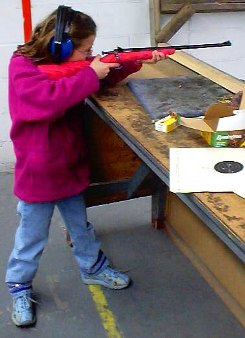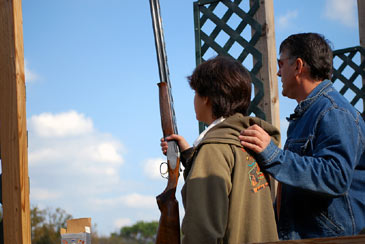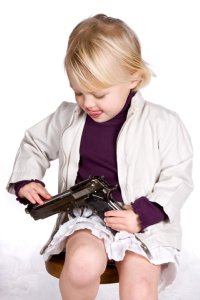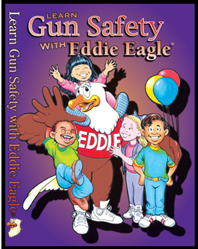|
Children and Firearms Safety Guns are in roughly half of the homes in the United States. Even if you don't have one, there may be firearms in the home of your child's friend. You need to talk to your children about firearms safety, particularly if they show any signs of interest, and remember, children are curious. If you don't talk with them, they will look for answers somewhere else. Children also need to be taught the difference between toy guns and real guns, as well as the difference between "TV and movie" guns and violence and real life guns. For very young children (kindergarten through 3rd grade), the National Rifle Association has a mascot – Eddie Eagle - for teaching firearms safety. Eddie Eagle's four common sense points are easy for kids to remember and are the same things we would tell a small child facing an open flame or other physical hazard:
That’s it and according the NRA – which cites various statistics about kids using this education in real life - it works. |
||
 We can't recommend an age when it is safe to teach a child how to handle a gun. It all depends on the maturity of the child and the individual situations of your family and home setting. We routinely see children - 8 to 12 years - in our local gun clubs being taught by grandparents, parents and friends.
Always teach firearms safety from day one. We can't recommend an age when it is safe to teach a child how to handle a gun. It all depends on the maturity of the child and the individual situations of your family and home setting. We routinely see children - 8 to 12 years - in our local gun clubs being taught by grandparents, parents and friends.
Always teach firearms safety from day one. Since we are filling multiple roles of parent (or grandparent) in addition to being the firearms instructor, the child may not always hear us as we want them to. It is a good idea to look into NRA or other youth programs to reinforce what we are teaching. Competitions are also excellent opportunities for a child (and the teacher) to see what the child knows and what they don't. Several manufacturer's offer youth models. Keystone Sporting Arms makes the Cricket (see picture) and Chipmunk. Both models are based on .22 caliber single shot bolt action guns with the added safety feature that the hammer needs to be manually set prior to each round by using a plunger at the rear of the barrel.  Do not confuse good behavior on the range with overall maturity in a young adult. A behavioral study found that kids with some firearms training are more likely to handle a firearm found hidden in a classroom than kids with no training. They were also more likely to pull the trigger. This is common sense from an adult perspective when we remember how cool it was to show off to our friends when we were younger. So, it is also advisable that access to the firearms away from the range remains restricted while children are still learning. Access to firearms, like other privileges of adulthood, is earned. Do not confuse good behavior on the range with overall maturity in a young adult. A behavioral study found that kids with some firearms training are more likely to handle a firearm found hidden in a classroom than kids with no training. They were also more likely to pull the trigger. This is common sense from an adult perspective when we remember how cool it was to show off to our friends when we were younger. So, it is also advisable that access to the firearms away from the range remains restricted while children are still learning. Access to firearms, like other privileges of adulthood, is earned. There is a story going around the internet about an 8 year old boy shooting an Uzi under the direction of an instructor. The gun's recoil was more than the boy could manage and somehow the gun fired straight up causing the child to shoot himself. The logistics are difficult to imagine and this may be just an urban myth, but it illustrates the point of not moving a child beyond their limits. While no one would ever give a pistol to three year old, we might try to rush things for the 10 year old who is eager to shoot their first white tail. Don't rush it, if the child isn't ready yet, there will be plenty of time later for larger caliber firearms and more challenging shots. Remember, while we are teaching the next generation about firearms, we are promoting maturity, respect and the safety skills necessary to enjoy a lifetime passion. These lessons carry through to other aspects of life as well. Here's a snippet from the web site Pulpless.com  Here's what a 1995 federal study investigating juvenile crime found after looking at 20,000 randomly selected households: Here's what a 1995 federal study investigating juvenile crime found after looking at 20,000 randomly selected households:
Relationship between type of gun owned and percent committing street, drug and gun crimes. Illegal gun: No gun: Legal Gun: "The socialization into gun ownership is also vastly different for legal and illegal gun owners. Those who own legal guns have fathers who own guns for sport and hunting. On the other hand, those who own illegal guns have friends who own illegal guns and are far more likely to be gang members. For legal gun owners, socialization appears to take place in the family; for illegal gun owners, it appears to take place 'on the street.'" "Boys who own legal firearms have much lower rates of delinquency and drug use and are even slightly less delinquent than non owners of guns." |
||
 |
||

Custom Search
|
||
 STOP!
STOP!